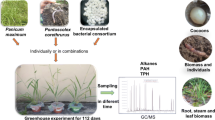Abstract
Background, Aim and Scope
Phytoremediation is a remediation method which uses plants to remove, contain or detoxify environmental contaminants. Phytoremediation has successfully been applied for the removal of fresh hydrocarbon contamination, but removal of aged hydrocarbons has proven more difficult. Biodegradation of hydrocarbons in the subsurface can be enhanced by the presence of plant roots, i.e. the rhizosphere effect. Phytostabilization reduces heavy metal availability via immobilization in the rhizosphere. Soils contaminated by both hydrocarbons and heavy metals are abundant and may be difficult to treat. Heavy metal toxicity can inhibit the activity of hydrocarbon-degrading microorganisms and decrease the metabolic diversity of soil bacteria. In this experiment, weathered hydrocarbon- and heavy metal- contaminated soil was treated using phytoremediation in a 39- month field study in attempts to achieve both hydrocarbon removal and heavy metal stabilization. Materials and Methods: A combination of hydrocarbon degradation and heavy metal stabilization was evaluated in a field-scale phytoremediation study of weathered contaminants. Soil had been contaminated over several years with hydrocarbons (11400±4300 mg kg dry soil)-1 and heavy metals from bus maintenance activities and was geologically characterized as till. Concentrations of soil copper, lead and zinc were 170±50 mgkg-1, 1100±1500 mg kg-1 and 390±340 mg kg-1, respectively. The effect of contaminants, plant species and soil amendment (NPK fertilizer or biowaste compost) on metabolic activity of soil microbiota was determined. Phytostabilization performance was investigated by analyses of metal concentrations in plants, soil and site leachate as well as acute toxicity to Vibrio fischeri and Enchtraeus albidus. Results: Over 39 months hydrocarbon concentrations did not decrease significantly (P=0.05) in non-amended soil, although 30% of initial hydrocarbon concentrations were removed by the last four months of study. In soil amended with NPK fertilizer and municipal biowaste compost, 65 % and 60 % of hydrocarbons were removed, respectively. The soil contained metabolically diverse bacteria, measured as carbon source utilization and extracellular enzymatic activities. Compost addition resulted in a slight increase in enzymatic activities. Diesel fuel utilization potential in Biolog MT2 plates inoculated with a soil suspension was enhanced by both compost and NPK compared to non-amended soil. Soil toxicity to V. fischeri and E. albidus was low. The leachate was not toxic to V. fischeri. Pine (Pinus sylvestris), poplar (Populus deltoides x Wettsteinii), grasses and clover (Trifolium repens) survived to varying degrees in the contaminated soil. All plants suffered from phytotoxicity symptoms and some trees died during the study period. Plants formed a dense cover over the compost-amended soil, whereas non-amended soil had areas devoid of vegetation throughout the study. Vegetation coverage in the NPK-amended quarter was about 50 % after the first four months of study, but increased gradually to 100 %. Heavy metals did not accumulate in plant tissue. Discussion: Removal of hydrocarbons from weathered unfertilized hydrocarbon-contaminated soil was not statistically significant despite the presence of a viable hydrocarbon-degrading microbial community. This effect is attributed to soil heterogeneity and low bioavailability of hydrocarbons. Hydrocarbon concentrations were not reduced to the desired level, i.e., 1500 mg hydrocarbons (kg of dry soil)-1, in any treatment. . The presence of clay minerals and organic matter within the compost may have limited heavy metal transfer to leachate and plant tissue. Conclusions: Weathered hydrocarbons were partly decomposed in soil fertilized with NPK fertilizer or biowaste compost, but not from unfertilized soil. The active hydrocarbon-degrading microbiota and low toxicity of soil to V. fischeri and E. albidus indicates low availability of contaminants to microorganisms. Despite high heavy metal concentrations, the soil contained metabolically diverse bacteria, measured as carbon source utilization and extracellular enzymatic activities. Heavy metals did not accumulate in test plants. Pine and poplar suffered from phytotoxicity symptoms in the soil and could not enhance hydrocarbon removal in compost-amended soil. Compost addition combined with a grass and legume crop is suggested for stabilization of combined hydrocarbon- and metal-contaminated soil. Recommendations and Perspectives: Both compost and NPK fertilizers can be used to enhance phytoremediation of soil contaminated with weathered hydrocarbons in the presence of heavy metals; however, compost addition is recommended since it enables greater vegetative coverage. This in turn may decrease heavy metal mobility. Phytoremediation can be used for remediation of soil contaminated with weathered hydrocarbons in the presence of heavy metals. However, phytoremediation of weathered contaminants requires extended periods of time; thus, other remediation methods should be considered in the event of soil contamination posing an immediate public health and/or environmental threat.
Similar content being viewed by others
Author information
Authors and Affiliations
Corresponding authors
Rights and permissions
About this article
Cite this article
Vaajasaari, K., Joutti, A. Field-Scale Assessment of Phytotreatment of Soil Contaminated with Weathered Hydrocarbons and Heavy Metals (9 pp). J Soils Sediments 6, 128–136 (2006). https://doi.org/10.1065/jss2006.07.170
Received:
Accepted:
Published:
Issue Date:
DOI: https://doi.org/10.1065/jss2006.07.170




